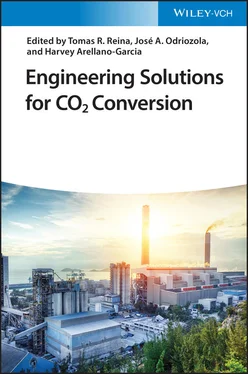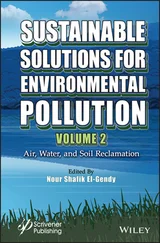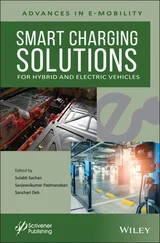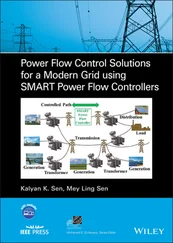The above examples show the benefits of the co‐simulation approach, in allowing the detailed interactions between fluid mechanics, heat transfer, reaction, and control strategy to be examined, and give valuable outputs to the design and operational model. The aforementioned examples also show that there is a lot to be done, given the scarcity of CFD process co‐simulation studies published in the literature. For instance, and to the best of the author's knowledge, no co‐simulation study has been reported regarding carbon utilization. As previously mentioned however, the combination of CFD and process simulations will certainly lead to significant research outcomes, especially in cases with CO 2utilization where new catalysts (CFD) need to be tested in a reactor (part of a bigger process simulation) in which steady‐state performance, dynamics, and control strategy depend on mixing and fluid flow behavior. More specifically, in the area of methanation, there are two different aspects that need to be combined: the methanation reactor configuration and the catalysts. Not only is the reactor design clearly influenced by the catalyst applied, its activity, and selectivity, but also are up‐ and downstream processes [69]. A tight interfacing between CFD calculations for the performance assessment of a given catalyst and process simulation tools for the reactor design will open the possibility for process modeling on a detailed and optimized approach.
It is evident from the aforementioned examples that the combination of process simulations and CFD will lead to a future with improved and optimized CCSU technologies. Also, the combination and implementation of different control strategies shall also provide an extra benefit.
1 1 Shaikh, A.R., Karchanechi, H., Kamio, E. et al. (2016). Quantum mechanical and molecular dynamics simulations of dual‐amino‐acid ionic liquids for CO2 capture. J. Phys. Chem. C 120 (49): 27734–27745.
2 2 Cygan, R.T., Romanov, V.N., and Myshakin, E.M. (2012). Molecular simulation of carbon dioxide capture by montmorillonite using an accurate and flexible force field. J. Phys. Chem. C 116 (24): 13079–13091.
3 3 Tao, M., Xu, N., Gao, J. et al. (2019). Phase‐change mechanism for capturing CO2 into an environmentally benign nonaqueous solution: a combined NMR and molecular dynamics simulation study. Energy Fuels 33 (1): 474–483.
4 4 Trinh, T.T., Tran, K.Q., Bach, Q.V., and Trinh, D.Q. (2016). A molecular dynamics simulation study on separation selectivity of CO2/CH4 mixture in mesoporous carbons. Energy Procedia 86: 144–149.
5 5 Wilcox, J. (2012). Carbon Capture. New York, NY: Springer Science + Business Media.
6 6 Raynal, L. and Royon‐Lebeaud, A. (2007). A multi‐scale approach for CFD calculations of gas‐liquid flow within large size column equipped with structured packing. Chem. Eng. Sci. 62 (24): 7196–7204.
7 7 Raynal, L., Ben, R.F., and Royon‐Lebeaud, A. (2009). Use of CFD for CO2 absorbers optimum design: from local scale to large industrial scale. Energy Procedia 1: 917–924.
8 8 Cooke, J.J., Armstrong, L.M., Luo, K.H., and Gu, S. (2014). Adaptive mesh refinement of gas‐liquid flow on an inclined plane. Comput. Chem. Eng. 60: 297–306.
9 9 Sebastia‐Saez, D., Gu, S., and Ramaioli, M. (2018). Effect of the contact angle on the morphology, residence time distribution and mass transfer into liquid rivulets: a CFD study. Chem. Eng. Sci. 176: 356–366.
10 10 Larachi, F., Petre, C.F., Iliuta, I., and Grandjean, B. (2003). Tailoring the pressure drop of structured packings through CFD simulations. Chem. Eng. Process. 42 (7): 535–541.
11 11 Sun, B., He, L., Liu, B.T. et al. (2013). A new multi‐scale model based on CFD and macroscopic calculation for corrugated structured packing column. AIChE J. 59 (8): 3119–3130.
12 12 Haroun, Y., Legendre, D., and Raynal, L. (2010). Direct numerical simulation of reactive absorption in gas‐liquid flow on structured packing using interface capturing method. Chem. Eng. Sci. 65 (1): 351–356.
13 13 Sebastia‐Saez, D., Gu, S., Ranganathan, P., and Papadikis, K. (2015). Micro‐scale CFD modeling of reactive mass transfer in falling liquid films within structured packing materials. Int. J. Greenhouse Gas Control 33: 40–50.
14 14 Said, W., Nemer, M., and Clodic, D. (2011). Modeling of dry pressure drop for fully developed gas flow in structured packing using CFD simulations. Chem. Eng. Sci. 66 (10): 2107–2117.
15 15 Pham, D.A., Lim, Y.I., Jee, H. et al. (2015). Porous media Eulerian computational fluid dynamics (CFD) model of amine absorber with structured‐packing for CO2 removal. Chem. Eng. Sci. 132: 259–270.
16 16 van Baten, J.M., Ellenberger, J., and Krishna, R. (2001). Radial and axial dispersion of the liquid phase within a KATAPAK‐S® structure: experiments vs. CFD simulations. Chem. Eng. Sci. 56 (3): 813–821.
17 17 Petre, C.F., Larachi, F., Iliuta, I., and Grandjean, B.P.A. (2003). Pressure drop through structured packings: breakdown into the contributing mechanisms by CFD modeling. Chem. Eng. Sci. 58: 163–177.
18 18 Raynal, L., Boyer, C., and Ballaguet, J.P. (2004). Liquid holdup and pressure drop determination in structured packing with CFD simulations. Can. J. Chem. Eng. 82: 871–879.
19 19 Fernandes, J., Simões, P.C., Mota, J.P.B., and Saatdjian, E. (2008). Applications of CFD in the study of supercritical fluid extraction with structured packing: dry pressure drop calculations. J. Supercrit. Fluids 47: 17–24.
20 20 Fernandes, J., Lisboa, P.F., Simões, P.C. et al. (2009). Application of CFD in the study of supercritical fluid extraction with structured packing: wet pressure drop calculations. J. Supercrit. Fluids 50: 61–68.
21 21 Isoz, M. and Haidl, J. (2018). Computational‐fluid‐dynamics analysis of gas flow through corrugated‐sheet‐structured packing: effects of packing geometry. Ind. Eng. Chem. Res. 57: 11785–11796.
22 22 Armstrong, L.M., Gu, S., and Luo, K.H. (2013). Dry pressure drop prediction within Montz‐pak B1‐250.45 packing with varying inclination angles and geometries. Ind. Eng. Chem. Res. 52 (11): 4372–4378.
23 23 Owens, S.A., Perkins, M.R., and Eldridge, R.B. (2013). Computational fluid dynamics simulation of structured packing. Ind. Eng. Chem. Res. 52 (5): 2032–2045.
24 24 Haroun, Y., Raynal, L., and Alix, P. (2014). Prediction of effective area and liquid hold‐up in structured packings by CFD. Chem. Eng. Res. Des. 92: 2247–2254.
25 25 Lautenschleger, A., Olenberg, A., and Kenig, E.Y. (2015). A systematic CFD‐based method to investigate and optimise novel structured packings. Chem. Eng. Sci. 122: 452–464.
26 26 Sebastia‐Saez, D., Gu, S., Ranganathan, P., and Papadikis, K. (2015). Meso‐scale CFD study of the pressure drop, liquid hold‐up, interfacial area and mass transfer in structured packing materials. Int. J. Greenhouse Gas Control 42: 388–399.
27 27 Li, Q., Wang, T., Dai, C., and Lei, Z. (2016). Hydrodynamics of novel structured packings: an experimental and multi‐scale CFD study. Chem. Eng. Sci. 143: 23–35.
28 28 Yang, L., Liu, F., Saito, K., and Liu, K. (2018). CFD modeling on hydrodynamic characteristics of multiphase counter‐current flow in a structured packed bed for post‐combustion CO2 capture. Energies 11 (11): 3103.
29 29 Asendrych, D., Niegodajew, P., and Drobniak, S. (2013). CFD modelling of CO2 capture in a packed bed by chemical absorption. Chem. Process Eng. 34 (2): 269–282.
30 30 Niegodajew, P. and Asendrych, D. (2016). Amine based CO2 capture – CFD simulation of absorber performance. Appl. Math. Modell. 40: 10222–10237.
31 31 Kim, J., Pham, D.A., and Lim, Y.I. (2016). Gas‐liquid multiphase computational fluid dynamics (CFD) of amine absorption column with structured packing for CO2 capture. Comput. Chem. Eng. 88: 39–49.
Читать дальше












